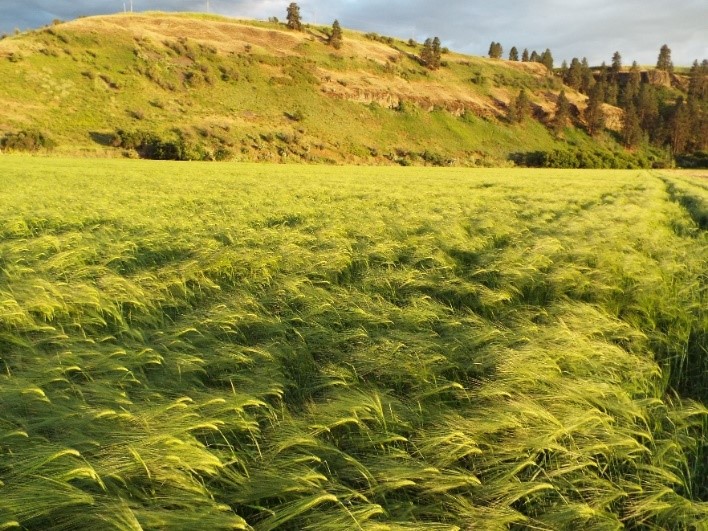The Northwest’s Olympic Peninsula is famous for hosting continental America’s only rain forest which averages about 150 inches of annual precipitation. That fact might make ocean-side grain culture there a hopeless prospect, but far from it on the dry and sunny north side of the Olympic Mountains. To the contrary, the imposing mountains shelter the vicinity of Sequim, Washington, from the region’s prevailing southwesterly winds to create a rain shadow effect causing only about fifteen inches of rain to fall in that area. The peculiar semi-arid climate combined with fertile landscape create ideal conditions for raising wheat, barley, and oats. Match the geography with the patriotic dream of Dan and Jan Abbot to build a full-scale replica of Mt. Vernon as a five star bed and breakfast and you get… the spectacular George Washington Inn.
Barley Field near Sequim on Washington’s Olympic Peninsula (2018)
The Abbots have been friends of Palouse Heritage since we first met several years ago at one of the WSU Grain Gathering conferences. Dan shares our interest in health and history and wanted to learn about the crops of America’s Colonial Era in order to provide a “living history” experience to visitors to the Inn. He might not have expected them to harvest the crop, but thought that establishing test plots with actual varieties that once grew at places like Mt. Vernon and Thomas Jefferson’s Monticello would be a fascinating project. And so was launched a partnership between Dan, the WSU Bread Lab in nearby Burlington, and Palouse Heritage.
British Army Reenactors approach the George Washington Inn (Mt. Vernon)
The third annual Northwest Colonial Festival was held at the Inn this past August with hundreds of visitors attending a series of special events and reenactor encampments of British regulars and American patriots. Along with demonstrations of tool making, cooking, printing, weaving, and other traditional crafts, the August sunshine brought the landrace grain plots to maturity. Many of the guests gathered under an enormous tent where longtime WSU senior agronomist Steve Lyon and I teamed up to tell about the various varieties and discuss the challenges and benefits of heritage grain production. Several once prominent early American grains like Virginia White and Red May also made their way to the Pacific Northwest by the late 1800s, and seeing bountiful stands again wave in the seaside breeze presents scenes worthy of a painting.
Three (Colonial) Musketeers
Early American Mediterranean Red Wheat Test Plot
One of the winter wheats planted last fall, Mediterranean Red, yielded terrifically and represents a remarkable chapter in the history of American agriculture. Most folks are familiar with the story of Hessian troops from Germany being used as mercenaries to fight for the British during the Revolutionary War. Many agricultural historians believe that these soldiers brought more with them to the Colonies that love of schnapps and sauerkraut. It seems that a tiny pernicious pest that came to be known as the Hessian fly likely arrived with the hay and grain brought over to provision the soldiers livestock. This insect wrought enormous havoc on cereal grains that had long been raised in North America, and local news and correspondence of George Washington and other farmers from the era is full of news about the calamity that ensured which threatened the food supply. Fortunately for the new nation, enterprising “farmer improvers” introduced Mediterranean Red which seemed to have a natural resistance to infestation. Scientists today study the remarkable genetic diversity of landrace grains that developed in locales throughout the world for millennia and continue to exhibit valued traits for hardiness, yield, and flavor.
Bridget Baker, Olympic Gold (oil on canvas, wheat field near Sequim), Palouse Heritage Collection

































